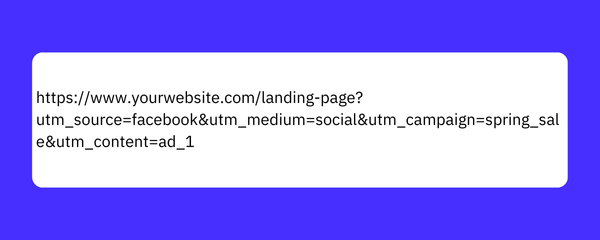Marketers use many ways to assess the efficacy of a campaign. One of the most popular tools contains ‘Urchin Tracking Module’ UTM codes. These codes appear at the end of URLs. Basically, these are used to identify certain sources of traffic to the website. In addition, it provides a traffic medium as well as keyword and content identifiers. Let’s get into the specifics of how UTM tagging works to assist in finding the highest performing content.
Table of Contents
What is UTM tagging?
UTM codes are like little spies attached to your website URL to keep an eye on who clicked and searched for your business. These little magical codes work behind the scenes to collect valuable data whenever someone clicks your URL. Whether it’s a Facebook post or email, these codes will ping you about who stumbled upon your website.
Moreover, these tags work as a bridge between parameters to your URLs, each one designed to answer a specific question. For example, there’s a specific code, ‘utm_source’.
This code plays a spy and uncovers the origin of the click and traffic coming to your website. Whether it’s social media or a search engine, it detects the activity on your URL. Another code, ‘utm_medium’ plays the role of an analyst. It detects and reveals the medium and avenue of the marketing. It could include CPC, CPM, or even organic traffic.
Additionally, it goes beyond basic origin. There’s another code, ‘utm_campaign’. It assigns a unique name to your campaign. For example, this code/tag identifies a campaign theme, e.g., summer sale,’ sign up, etc.
And finally, the ‘utm_content’ parameter helps identify and differentiate between similar links. To do that, you can perform A/B testing to see which version the visitor clicked.
Why is UTM Tagging Important?
UTM tagging is not only about numbers. It helps make smart and better marketing decisions. It plays the role of a magnifying glass to see the bigger picture of your business. Here’s how UTM tags help you conquer your marketing campaigns and make informed decisions:
Measure Marketing Performance
First things first, tags reveal which mediums are most effective in bringing traffic and visitors. Is it your engaging Facebook postings or your carefully targeted email campaigns? By determining which sources generate the most traffic, you can concentrate your efforts. You can better pick the best channel that resonates most strongly with your audience.
Not every traffic is equal and converts. UTM helps identify which content resonates best with the visitors and also converts. For example, a blog post attracts a large volume of clicks and converts less. This content gap is analyzed by UTM tags, and it optimizes posts to bring more sales to the table.
Moreover, UTM tags are great to analyze the performance of each marketing campaign you run. For example, does your summer sale promotion outperform your webinar signup campaign? These insights and data help replicate successful campaigns and refine those that need a little more improvement.
Optimize Marketing Strategies
UTM tagging not only works as your spy but also reveals where you can excel in your marketing campaign. For example, if you run a social media campaign that feels like cricket chirps, these tags help you identify the problem. When you diagnose your problem, you will better refine your strategies to attract maximum reach for your campaign.
Not just social media, but UTM tags go beyond this. For example, your blog post is performing best in attracting traffic and readers but fails to convert them into loyal subscribers. It detects the problems by analyzing the content and user behavior. It offers a better and clearer call to action that aligns with your conversion goals.
These tags show what’s working and where there’s room for improvement. Having these insights helps optimize your marketing strategies on multiple fronts. It empowers website owners to continuously improve their marketing approach.
Attribution Models
UTM tags and attribution modeling act like a little breadcrumb. It helps you track where someone came from on your website. For example, it could be social media, email, or even search engines. This is how attribution modeling works. It takes those breadcrumbs and uses them to identify how much each touchpoint deserves.
It comes with many attribution models. The model’s simplest form is first-touch attribution. It credits the medium from which the visitor arrived, such as social media. Furthermore, there is a multi-touch model that takes into account all of the basis points associated with the client journey. Using this model, you can acquire a holistic knowledge of your campaign.

Boost ROI
As we have already stated, UTM tags allow you to improve your marketing strategy. They examine your content and sources to determine which information is doing best on your website. With that in hand, you can make more educated selections. Instead of continuing to invest in ineffective ad formats that fail to drive visitors and convert, you’ll be in a better position to use your resources wisely.
This optimization method helps to attract relevant clicks, which convert and increase ROI. This focused strategy ensures that you get the most out of your marketing effort and money. So, it’s all about how you manage your budget wisely and create long-term marketing success.
How to Create Your Own UTM Tags?
You can create your own UTM tags using the Builder tool. Using this tool, you may construct your own personalized URL, guaranteeing that you capture useful information. The Google UTM builder serves as both a builder and a cheat sheet, outlining each feature so you can easily produce perfect tracking codes. Consider it a success guide, making sure to include all of the relevant aspects (source, medium, campaign name, and so on) when creating a data-rich tracking URL.
These codes provide length to your URL and make it clunky. Google understands and makes their builder integrate with the URL shortening tool ‘Bitly.’ So, here’s a secret sauce for minimizing the length of your URL with a few clicks. These bit-sized URLs are in perfect form to be shared across different marketing platforms.
So, if you want to create your own customized URL, ditch the manual code-building and instead use URL builders. It empowers you to focus on creating compelling messages without fussing with complex code.
How to Use UTM Parameters for Your URLs
Don’t be scared by UTM codes, which appear to be a mess of letters and symbols. These small snippets appended to your website URLs reveal a wealth of information about your marketing activities. Here is a brief lesson on how to use UTM codes properly.
Tag What You Can Control
Use these tags to track your traffic from any source and medium you control. Even if it is unpaid. For example, if you send a newsletter, you can tag those links. If you are promoting content or a blog post on social media, tag UTM on it. You can gain a clear picture of where your traffic comes from.
Consistency is Key
Choose a system for each parameter (source, media, campaign name) and adhere to it religiously. This guarantees that everyone in your business uses the same “language” when establishing UTM codes, making data analysis easier.
Uppercase or Lowercase
Decide whether you want your codes in all lowercase (utm_source) or proper case (UTM_Source) and stick to that pattern. When it comes to data analysis, mixing things together leads to confusion. Consider a summer sale campaign that appears as “summer-sale” and “Summer-Sale” in your reports – not ideal!
Choose Short, Sweet, & Descriptive Campaign Name
Consider your campaign names to be mini-billboards: they should be concise, clear, and informative. Abbreviations are useful here, as long as everyone knows them. For instance, ‘summer sale’ is superior to ‘our amazing summer sale extravaganza.’ Also, prioritize what makes the campaign special. Promoting a product in a certain country? Add the country code to the name.

Source it Right
The “utm_source” tag functions similarly to a detective badge, showing the source of your traffic. Is it a social networking site, like Facebook? Use their name (such as “hasoffers”). Email marketing campaign? Use an email service provider (such as “Mailchimp”). Using explicit source tags allows you to see which channels are delivering the most traffic.
Consider CPC
Here’s a useful shortcut for bought traffic: always set the “utm_medium” tag to “cpc” (cost-per-click). Many systems, such as Google Ads, automatically include this parameter in your links, making it simple to distinguish between sponsored and organic traffic in your analytics report
UTM Tagging Mistakes to Avoid
UTM codes are like microscopic spies implanted in your website links, gathering information on where your users are coming from. However, even with such advanced technologies, marketers may make mistakes. Below are the top three UTM tagging errors to avoid:
Irrelevant Tagging
It may surprise you, but certain marketers fail to tag their links at all. This is analogous to sending your detective on a task without instructions: they won’t know where to seek or what data to acquire. UTM codes guarantee that you collect useful data on each visitor, providing a comprehensive picture of your marketing activities.
Inconsistent Code
Using various words for the same item, such as ‘paid’ or ‘CPC,’ causes confusion in the data. Make explicit guidelines for each aspect (source, medium, campaign) and follow them. This ensures that your data is structured and provides a clear picture of your marketing channels.
Using Different Cases for Same Tag
Determine if your codes prefer all lowercase (utm_source) or proper case (UTM_Source) and adhere to that pattern throughout. When it comes to data analysis, mixing things together leads to confusion.
Empower Your Marketing Decisions With Utm Tags
UTM tags may look like technical jargon, but they are your hidden weapon for marketing success. These small snippets appended to your website URLs provide a wealth of information about where your visitors originate from and what content connects with them. Following the suggestions in this post will help you learn UTM tags and turn your marketing efforts from guesswork to data-driven strategy.
For more similar blogs, visit EvolveDash today!
FAQs
- Can I use UTM tags on internal links within my website?
No, UTM tags should only be used for external links. Using them on internal links can cause tracking issues and mislead analytics data by creating false session starts.
- Are UTM tags case-sensitive?
Yes, UTM tags are case-sensitive. For example, “utm_source=Facebook” and “utm_source=facebook” will be tracked as two different sources in analytics. Always keep the formatting consistent.
- Will UTM tags impact my SEO or search rankings?
No, UTM parameters do not affect SEO directly. They are used for tracking purposes only. However, avoid overusing them on public-facing pages to keep URLs clean and user-friendly.
- How long do UTM tags track a user?
UTM tags track data for a single session or click. Once the visitor lands on the page, Google Analytics stores the information in the session data. They do not track users beyond the initial click.
- Can I track conversions using UTM tags alone?
No, UTM tags only track where the traffic comes from. To track conversions, you must set up conversion goals or events in your analytics platform. UTM tags help connect the source to the conversion when goals are properly set.



















